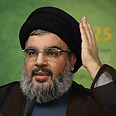
Leader of Hezbollah Hassan Nasrallah
צילום: AFP
The secret war continues
Latest explosions in Lebanon another chapter in clandestine battle
Israel, Lebanon, Syria, Iran, and Hezbollah are engaged in a war. Only the tip of the iceberg surfaces once in a while, yet this is a war in every way, and it takes place every day and every hour. On Sunday, according to Lebanese sources, we saw one of the rare appearances of this war in the public arena.
The beginning of what we saw on Sunday was a huge blast in the heart of Damascus on February 12, 2007. Just like all the other people residing in the Damascus neighborhood, people at 17 Nissan Street also must have rushed to the window to see what happened. They saw a giant flame that resulted from the explosives planted in the jeep that blew up, killing Imad Mugniyah.
A European diplomat who at the time was deployed in Damascus said that the horror of this assassination, which was attributed to Israel’s Mossad, could be seen not only in the eyes of Hezbollah, Hamas, and Islamic Jihad members who reside in Damascus. It was also apparent in the embarrassed looks in the eyes of members of Syria’s defense and intelligence establishment. They realized that if Mugniyah can be blown up at the heart of the city’s most secure neighborhood, it is possible to reach any site – even 17 Nissan Street.
The above address is the home of the Syrian atomic agency’s (AECS) large complex. The hundreds of people employed in the compound already sustained a grave blow five months before that, after seven Israeli Air Force jets turned the Syrian attempt to produce a nuclear bomb with North Korea’s help into dust. Mugniyah’s assassination, steps away from them, certainly did not add to their sense of security.
In the wake of the assassination, the defense and internal security establishments of Syria, Lebanon, and Hezbollah embarked on an aggressive search for the assassins or any sign of a leak. This search was similar to the one for people who may have leaked information about Syria’s nuclear project. On both fronts, the mystery still looms large for the three interested parties: Syria, Iran, and Hezbollah.
Who’s winning the war?
The Syrians and Iranians always feared Israeli bugging. Throughout the 1960s, the Syrians discovered on several occasions strange devices hidden underground. When they attempted to dismantle them, the devices exploded and killed the technicians. The next time it happened to them was in the beginning of March 1978, when they engaged in infrastructure work around a phone line that connected a military base to the Damascus switchboard. The device exploded, killing 12 people.
This did not only happen in Syria. In the “October War” museum in Cairo, there is a phone pole on display that the Egyptians claim was replaced by Israeli Special Forces by another pole containing a bugging device.
In the wake of the strike on the Syrian reactor, Mugniyah’s assassination, the bombing of the arms convey from Iran to Hamas via Sudan, and other incidents that made them feel transparent to Israel’s intelligence services, Hezbollah, Lebanon’s internal security service, the Iranians, and the Syrians embarked on an attempt to identify the sources of the leak that prompted the deeds attributed to Israel. Simultaneously, the Lebanese received American training and technical assistance that greatly advanced their technological capabilities to uncover spies.
So who’s winning this secret war? If Israel indeed stood behind the espionage ring exposed in Lebanon and the planting of the bugging devices, as the Lebanese media claim, then Jerusalem sustained several harsh blows in the past year. On the other hand, only those who do nothing never make mistakes. During this period, Hezbollah experienced two highly embarrassing incidents where illegal arms depots blow up, not to mention the group’s inability to avenge Mugniyah’s killing and its fear of a major clash with Israel.
Ronen Bergman, a correspondent for Israel’s largest daily Yedioth Ahronoth, is the author of the “The Secret War With Iran”










